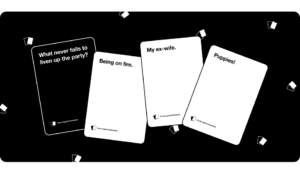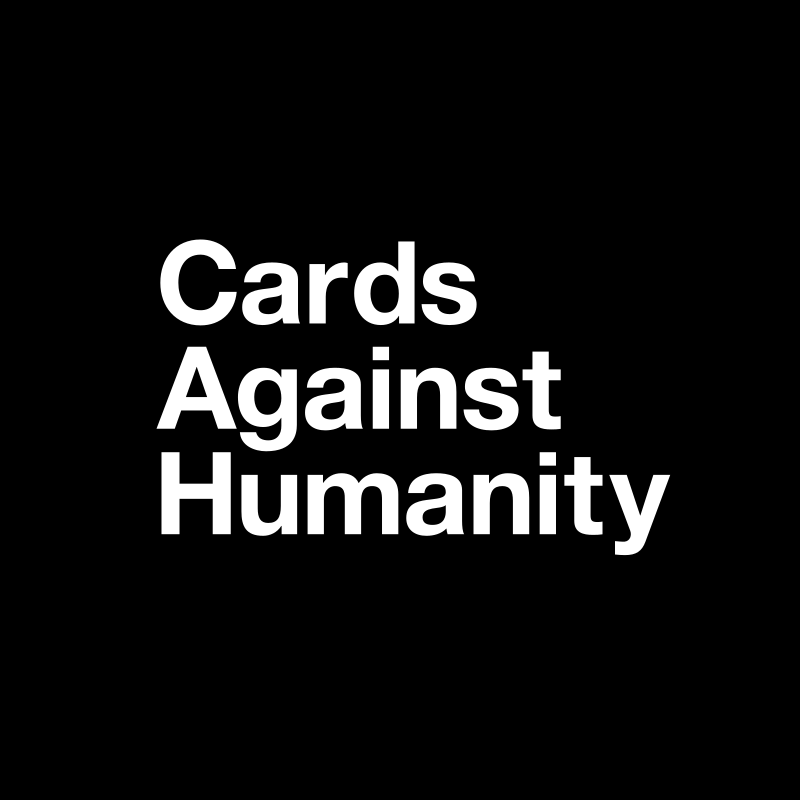For this critical play, I will discuss Cards Against Humanity, an adult party game created by eight Highland Park High School alumni (Josh Dillon, Daniel Dranove, Eli Halpern, Ben Hantoot, David Munk, David Pinsof, Max Temkin, and Eliot Weinstein) in 2011. It is a card game that involves completing and judging humorous fill-in-the-blank statements. The target audience is players aged 17+, which makes sense given the “mature” content that players must use to create these statements.
Formal elements
The number of players is listed as 3-20+. You need at least 3 players (two competitors, 1 judge), and the game can always add additional players. To start the game, each player draws 7 white cards (nouns or gerunds). One player begins as the Card Czar, and they play, face up, and read aloud a black card (fill-in-the-blank statements or questions). The other players choose and give to the Card Czar a white card (or how many are required by the black card) to couple with the black card, face down. The Card Czar then shuffles the white cards, reads each set aloud, and chooses whichever white card(s) they deem to be the most humorous, thereby granting the player who presented the card(s) a point. This constitutes one round. For each following round, the Card Czar role will switch to a new player and everyone redraws cards up to 7. There is no set end rule to the game, but generally, players play until one player reaches n points. It follows that the type of player dynamic is multilateral competition.

Kind of fun, why this game works, and improvements
The types of fun in Cards Against Humanity are Expression and Fellowship. The former, Expression, is also likely the primary reason why this game works. Notably, the white and black cards generally contain explicit, politically incorrect, and risque phrases. The purpose of each round is also to create humorous statements for the group and specifically for the Card Czar. The combination of these two dynamics allows for a certain type of humor that many 17+ players will enjoy and for lots of creativity. Sometimes, you might find the perfect white card as part of your hand, which allows for a great combination to present to the Card Czar, and other times, you might find a hand of random cards, which can in fact also allow for a great combination—the phrases can be so ridiculous that even a random combination would be very funny, forcing everyone to really use their imagination and interpretation. (However, we often find that some cards may be so random or specific that they would never be well-paired with a black card. This means that these cards may stay in your hand for a very long time. Perhaps there could be mechanics to drop cards to allow players to more consistently possess a large number of good potential cards.) Relatedly, we observe Fellowship. These explicit and humorous combinations can bring laughter and bonding to the group, as players share laughs and learn or affirm each others’ senses of humor.
Comparison, vulnerability, and what could be improved
The game is heavily influenced by Apples to Apples, a popular card Judging Game. Certainly, what differentiates Cards Against Humanity is the content and target audience. As emphasized, Cards Against Humanity is often offensive, politically incorrect, and dark. On the other hand, games like Apples to Apples are more wholesome and designed for families. This does not make either better or worse; rather, it just means that the target audiences are different, so it makes sense that the target audience for Cards Against Humanity is for adults (17+).
Because of its content and target audience, Cards Against Humanity requires quite a bit of vulnerability from the players. Players do not need to reveal anything about themselves, but at the same time, they are revealing a bit about themselves when they present a set of inappropriate cards that they put together themselves. Players may need or want to be familiar with their fellow players in regards to comfortability with mature and sensitive topics, which means it may be difficult to play with players you do not know as well.



